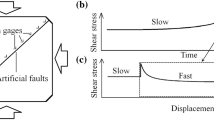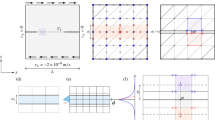Abstract
In seismically active regions, faults nucleate, propagate, and form networks that evolve over time. To simulate crustal faulting processes, including the evolution of fault-zone properties, a rheological model must incorporate concepts such as damage rheology that describe the various stages of the seismic cycle (strain localization, subcritical crack growth and macroscopic failure) while accounting for material degradation and healing and off-fault deformation. Here we study the fundamental patterns of strain-localisation within the framework of a continuum damage rheology by performing a shear band analysis (linear instability analysis) and comparing predictions of shear band orientations with numerical results of the nonlinear problem. We find (analytically and numerically) that the angle between the shear band and the less compressive (transverse) direction is between 47° in compression tests with a strain ratio of 0.25 (highly confined compression test), and 60° for a strain ratio higher than 1.4 (axial compression and transverse extension). In addition we find that shear bands exhibit local dilation (I 1 > 0) in a wide range of strain ratios excluding only simulations with highly confined compression (which yield compacting shear bands or non-localized deformation). Finally, we discuss the applicability of the damage model for simulating deformation in the seismogenic, brittle crust.




Similar content being viewed by others
References
Allix, O. and Hild, F. (2002), Continuum Damage Mechanics of Materials and Structures, Elsevier, p. 396. Amsterdam Holland.
Alm, O., Jaktlund, L.L., and Kou, S. (1985), The influence of microcrack density on the elastic and fracture mechanical properties of Stripa granite, Phys. Earth Planet. Inter., 40, 161–179.
Aydin, A., Borja, R., Eichhubl, P. (2006), Geological and mathematical framework for failure modes in granular rock. J Struct. Geol 28:83–93.
Bardet J. P. (1991), Orientation of shear bands in frictional soils. J. Eng. Mech. 117:1466–1484.
Baud, P., Klein, E., Wong, T-F., (2004), Compaction localization in porous sandstones: spatial evolution of damage and acoustic emission activity. J Struct Geol 26:603–624.
Ben-Zion, Y. and Sammis, C. (2003), Characterization of Fault Zones, Pure Appl. Geophys. 160, 677–715.
Ben-Zion, Y. and Lyakhovsky, V. (2006), Analysis of aftershocks in a lithospheric model with seismogenic zone governed by damage rheology, Geophys. J. Int. 165, 197–210.
Ben-Zion, Y. (2008), Collective Behavior of Earthquakes and Faults: Continuum-Discrete Transitions, Progressive Evolutionary Changes and Different Dynamic Regimes, Rev. Geophysics, 46, RG4006, doi:10.1029/2008RG000260, 2008.
Besuelle, P. (2001), Compacting and Dilating Shear Bands in Porous Rock: Theoretical and Experimental Conditions, J. Geophys. Res. 106, 13435–13442.
Biot, M.A. (1965), The mechanics of incremental deformations, Wiley, New York.
Buck, W.R. (1991), Models of Continental Lithosphere Extension, J. Geophys. Res, 96(B12), 20161–20178.
Budiansky, B. and O’Connell, R. J. (1976), Elastic moduli of a cracked solid, Int. J. Sol. Struct. 12, 81–97.
Challa and Issen, (2004), Conditions for compaction band formation in porous rock using a two yield surface model, Journal of Engineering Mechanics 130 (2004), pp. 1089–1097.
Chen, W.F. (1975), Limit analysis and soil plasticity, Elsevier, Amsterdam.
Chester, F. M., and Logan, J.M. (1986), Implications for mechanical properties of brittle faults from observations of the Punchbowl fault zone, California. Pure Appl. Geophys. 124, 79–106.
Chester, F. M., Evans, J. P., and Biegel, R. L. (1993), Internal structure and weakening mechanisms of the San Andreas Fault, J. Geophys. Res. 98, 771–786.
Desrues, J., Chambon, R., (2002), Shear band analysis and shear moduli calibration, International Journal of Solids and Structures 39, 3757–3776.
England, P. (1983), Constraints on Extension of Continental Lithosphere, J. Geophys. Res., 88(B2), 1145–1152.
Evans, J. P., Shipton, Z. K., Pachell, M. A., Lim, S. J., and Robeson, K. (2000), The structure and composition of exhumed faults, and their implication for seismic processes. In Proc. of the 3rd Confer. on Tecto. problems of the San Andreas system, (Stanford University 2000).
Finzi, Y., Hearn, E.H., Ben-Zion, Y., and Lyakhovsky, V. (2009), Structural properties and deformation patterns of evolving strike-slip faults: Numerical simulations incorporating damage rheology. Pure and Appl. Geophys., vol. 166, N. 10, 2009.
Finzi, Y., Hearn, E. H., Lyakhovsky, V., and Gross, L. (2011), Fault-zone healing effectiveness and the structural evolution of strike-slip fault systems, Geophys. J. Int., 186, 963–970.
Gibbs, A.D. (1984), Structural evolution of extensional basin margins, J. Geo. Society 141, pp. 609–620.
Gross, L., Bourgouin, L., Hale, A. J., and Muhlhaus, H. (2007), Interface modelling in incompressible media using level sets in Escript, Physics of the Earth and Planetary Interiors, 163, 23–34, doi:10.1016/j.pepi.2007.04.004.
Gross, L., Muhlhaus, H., Thorne, E., and Steube, K. (2008), A new design of scientific software using Python and XML, Pure Appl. Geophys., 165, 653–670, doi:10.1007/s00024-008-0327-7.
Hamiel, Y., Liu, Y., Lyakhovsky, V., Ben-Zion, Y., and Lockner, D. (2004a), A visco-elastic damage model with applications to stable and unstable fracturing, Geophys. J. Int. 159, 1155–1165.
Hamiel, Y., Lyakhovsky, V., and Agnon, A. (2004b), Coupled evolution of damage and porosity in poroelastic maedia: theory and applications to deformation of porous rocks, Geophys. J. Int. 156, 701–713.
Hamiel, Y., Lyakhovsky, V., and Agnon, A. (2005), Poroelastic damage rheology: Dilation, compaction, and failure of rocks. Geochem. Geophys. Geosyst., 6, Q01008, doi:10.1029/2004GC000813.
Hamiel, Y., Lyakhovsky, V., Ben-Zion, Y. (2011), The elastic strain energy of damaged solids with applications to nonlinear deformation of crystalline rocks. Pure Appl. Geophys., doi:10.1007/s00024-011-0265-7.
Hill, R. and Hutchinson, J.W. (1975), Bifurcation phenomena in the plane strain tension test, J. Mech. Phys. Solids 23, pp. 239–264.
Hill, R. (1998), The Mathematical Theory of Plasticity, Oxford University Press, Oxford.
Hobbs, B. E., Muhlhaus, H.-B., Ord, A. (1990), Instability, softening and localization of deformation. In: A.Deformation mechanisms, rheology and tectonics. Editors: Knipe R.J., Rutter E.H., Geol. Soc., London; Special Publication, 54, 143–165.
Holocomb D., J.W. Rudnicki, K.A. Issen, K. Sternlof, (2007), Compaction localization in the Earth and the laboratory: state of the research and research directions, Acta Geotechnica (2007) 2:1–15, doi:10.1007/s11440-007-0027-y.
Issen, K. A., and V. Challa, (2008), Influence of the intermediate principal stress on the strain localization mode in porous sandstone, J. Geophys. Res., 113, B02103, doi:10.1029/2005JB004008.
Kim, Y. S., Peacock, D. C. P., and Sanderson, D. J. (2004), Fault damage zones, J. Struct. Geology 26, 503–517.
Lemiale, V., Muhlhaus, H.-B., Moresi, L., Stafford, J. (2008), Shear banding analysis of plastic models formulated for incompressible viscous flows. Physics of the Earth and Planetary Interiors Volume 171, Issue 1–4, 177–186.
Lockner, D.A., Byerlee, J.D., Kuksenko, V., Ponomarev, A., and Sidorin, A., (1992), Observations of quasi-static fault growth from acoustic emissions, in Fault Mechanics and Transport Properties of Rocks, International Geophysics Series, Vol. 51, 3–31, eds. Evans, B. & Wong, T.-F., Academic Press, San Diego, CA.
Lubliner, J. (1990), Plasticity Theory, Macmillan Publishing, New York.
Lyakhovsky, V. and Myasnikov, V. P. (1984), On the behavior of elastic cracked solid, Phys. Solid Earth 10, 71–75.
Lyakhovsky, V. and Myasnikov, V. P. (1985), On the behavior of visco-elastic cracked solid, Phys. Solid Earth 4, 28–35.
Lyakhovsky, V., Ben-Zion, Y., and Agnon, A. (1997a), Distributed damage, faulting, and friction, J. Geophys. Res. 102, 27,635–27,649.
Lyakhovsky, V., Reches, Z., Weinberger, R., and Scott, T.E. (1997b), Non-linear elastic behavior of damaged rocks, Geophys. J. Int. 130, 157–166.
Lyakhovsky, V., Ben-Zion, Y., and Agnon, A. (2001), Earthquake cycle, faults, and seismicity patterns in rheologically layered lithosphere, J. Geophys. Res. 106, 4103–4120.
Lyakhovsky, V. and Hamiel, Y. (2007), Damage evolution and fluid flow in poroelastic rock. Izvestiya, Physics of the Solid Earth, 43: 13–23.
Lyakhovsky, V. and Ben-Zion, Y. (2008), Scaling relations of earthquakes and aseismic deformation in a damage rheology model, Geophys. J. Int. 172, 651–662, doi:10.1111/j.1365-246X.2007.03652.x.
Lyakhovsky, V. and Ben-Zion, Y. (2009), Evolving geometrical and material properties of fault zones in a damage rheology model, Geochem. Geophys. Geosyst., 10, Q11011, doi:10.1029/2009GC002543.
Malvern, L.E. (1969), Introduction to the Mechanics of a Continuum Medium (New Jersey, Prentice-Hall, Inc., 1969), 713 pp.
Menendez, B., W. Zhu and T.F. Wong, 1996, Micromechanics of brittle faulting and cataclastic flow in Berea sandstone, Journal of Structural Geology 18, 1–16.
Mitchell T. and D. Faulkner, (2009), The nature and origin of off-fault damage surrounding strike-slip fault zones with a wide range of displacements: A field study from the Atacama fault system, northern Chile, Journal of Structural Geology 31, 802–816, doi:10.1016/j.jsg.2009.05.002.
Moresi, L. and Muhlhaus, H.B. (2006), Anisotropic viscous models of large-deformation Mohr-Coulomb failure, Phill. Magazine 86, pp.3287–3305.
Muhlhaus, H.-B., Vardoulakis, I. (1987), Thickness of shear bands in granular materials, Geotechnique. Volume 37, Issue 3, September 1987, Pages 271–283.
Olsson, W.A., 1999. Theoretical and experimental investigation of compaction bands. Journal of Geophysical Research 104, 7219–7228.
Rice, J.R., (1983), Constitutive relations for fault slip and earthquake instabilities. Pure Appl. Geophys. 121, 443–475.
Rockwell, T. K. and Ben-Zion, Y. (2007), High localization of primary slip zones in large earthquakes from paleoseismic trenches: Observations and implications for earthquake physics, J. Geophys. Res. 112, B10304, doi:10.1029/2006JB004764.
Rudnicki, J. W., and Rice, J. R. (1975), Conditions for the localization of deformation in pressure-sensitive dilatant materials, J. Mech. Phys. Solids, 23, 371–394.
Rudnicki, J. W., and Olsson, W. A. (1998), Re-examination of fault angles predicted by shear localization theory, Int. J. Rock Mech. Min. Sci., 35, 4–5.
Rudnicki R.W., (2002), Conditions for compaction and shear bands in a transversely isotropic material. International Journal of Solids and Structures 39, 3741–3756.
Schultz R.A., R. Soliva, H. Fossen, C.H. Okubo and D.M. Reeves, (2008), Dependence of displacement–length scaling relations for fractures and deformation bands on the volumetric changes across them, Journal of Structural Geology 30, pp. 1405–1411.
Schulz, S. E. and Evans, J. P. (2000), Mesoscopic structure of the Punchbowl Fault, Southern California and the geologic and geophysical structure of active strike-slip faults, J. of Struct. Geol. 22, 913–930.
Schreyer H. L. and Chen Z. (1986), One-dimensional softening with localization, J. Appl. Mech. 53, 791 (1986), doi:10.1115/1.3171860.
Sibson, R. H. (2003), Thickness of the seismic slip zone, Bull. Seismol. Soc. Am. 93, 3, 1169–1178.
Turcotte, D. L. and Glasscoe, M.T. (2004), A damage model for the continuum rheology of the upper continental crust, Tectonophysics 383, 71–80.
Tvergaard, V., Needleman, A. and Lo, K.K. (1981), Flow localization in the plane strain tensile test, J. Mech. Phys. Solids 29, pp. 115–142.
Walsh, J., Wattersov, J. and Yielding, G. (1991), The importance of small-scale faulting in regional extension, Nature 351, pp. 391–393.
Watts, A.B., Bondie, J.H. and Steckler, M.S. (1980), Observation of flexure and the state of stress in the oceanic lithosphere, J. Geophys. Res. 85, pp. 6369–6376.
Wong, T., David, C. and Zhu, W. (1997), The transition from brittle faulting to cataclastic flow in porous sandstones: Mechanical deformation, J. Geophys. Res., 102, 3009–3025.
Wu, X. Y., P. Baud and T. F. Wong, (2000), Micromechanics of compressive failure and spatial evolution of anisotropic damage in Darley Dale sandstone, International Journal of Rock Mechanics and Mining Sciences 37, pp. 143–160.
Author information
Authors and Affiliations
Corresponding author
Rights and permissions
About this article
Cite this article
Finzi, Y., Muhlhaus, H., Gross, L. et al. Shear Band Formation in Numerical Simulations Applying a Continuum Damage Rheology Model. Pure Appl. Geophys. 170, 13–25 (2013). https://doi.org/10.1007/s00024-012-0463-y
Received:
Revised:
Accepted:
Published:
Issue Date:
DOI: https://doi.org/10.1007/s00024-012-0463-y




